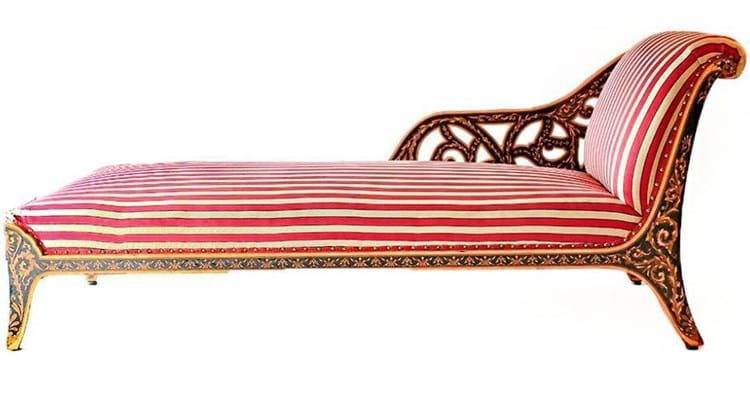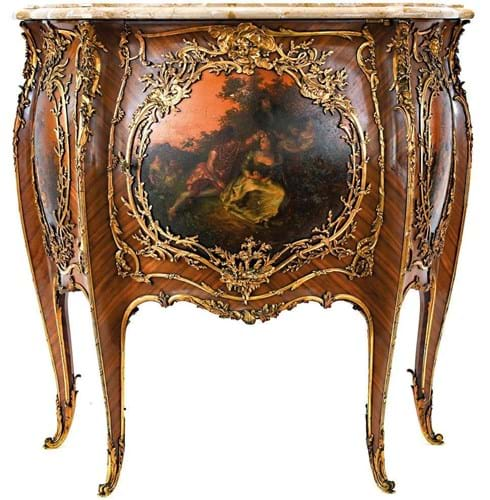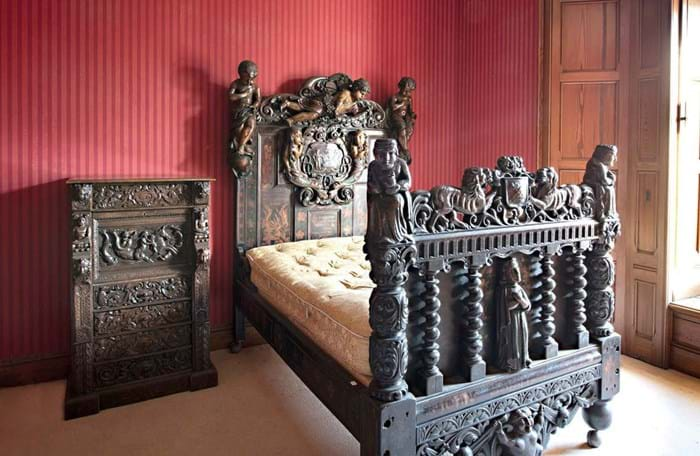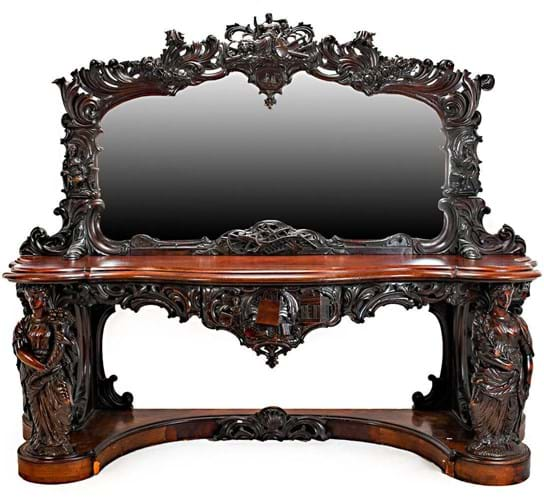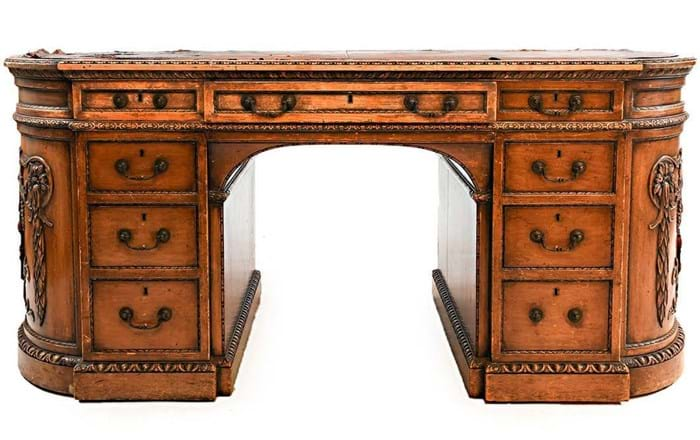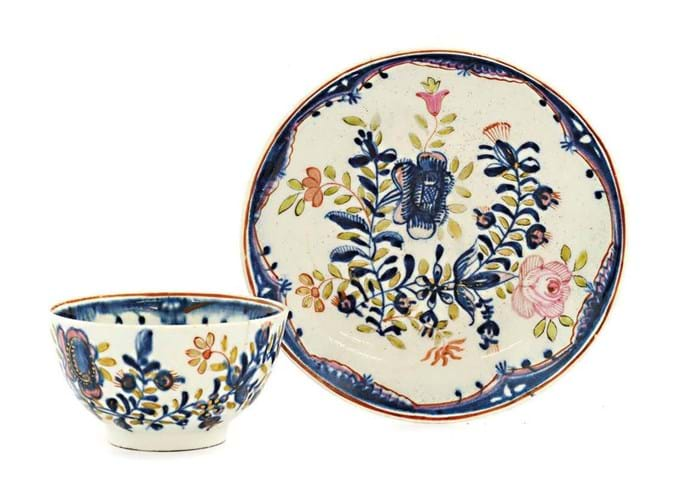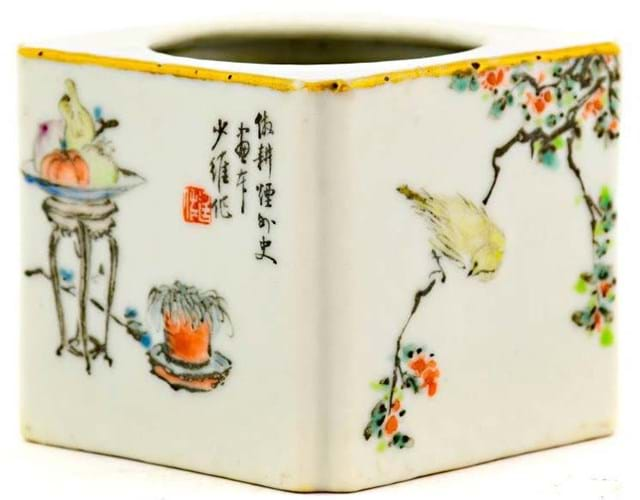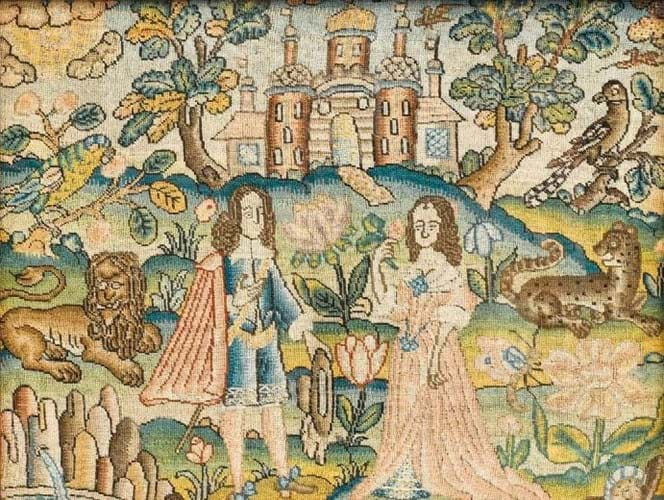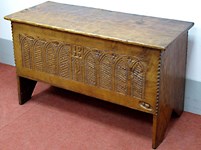Three 19th century chaise longues featured in Tennants’ (22% buyer’s premium) Fine Spring Sale at Leyburn. One c.1870 covered in calico took £160. Another c.1830 of carved mahogany brought £420.
The last, however, an elegant Aesthetic movement form with marquetry decoration, was estimated at £700-1000 but sold to a south of England buyer at £26,000.
It breathed quality but at that price something more was clearly in play.
The chaise longue had been identified by knowledgeable bidders as a design by Owen Jones (1809-74) and made by noted London cabinet makers Jackson and Graham. A handful of other examples are known including that made as part of a large suite for James Mason (1824-1903) of Eynsham Hall, Oxfordshire in 1873.
The original watercolour designs for the proposed furnishing of Eynsham are in the collection of the library of Reading University, while elements of the finished furniture were donated to the V&A in 1954 when the building became a police training college. It appears that the upholstered elements were originally covered with a woven Jacquard silk to Jones’ design called Sutherland.
Special touch
With specialist sales in multiple disciplines now the fashion in Leyburn, the designated Spring Sale on March 19 was much smaller than the mammoth three-day affairs of yesteryear. But the 413 lots totalled £512,740 with a 90% selling rate and covered the field of collecting.
Another exceptional example of late 19th century furniture was a Louis XV style kingwood bombé commode in the manner of the renowned 19th century Paris maker François Linke.
The 3ft 3in (1m) wide commode, with later marble top above a cupboard painted with 18th century figures in a landscape, had only minor condition problems and raised Continental interest before selling to a north African bidder at a treble-estimate £22,000.
Most of the better prices for 18th century and earlier furniture came for overseas material.
One was an American cherry and pine-lined Chippendale-style chest of drawers indistinctly inscribed George Yeadly Hudson. The 3ft 9in (1.14m) wide serpentine chest had some condition problems but generated interest among American bidders before selling to one of them at £3000, 10 times the lower estimate.
A part 17th century Spanish polychrome and stained oak bed profusely carved all over with saints, angels, cupids, maids, coats of arms was provenanced to musician Ned Lambton, the 7th Earl of Durham.
Measuring 4ft 11in wide x 6ft 9in long x 6ft 9in high at the headboard (1.5 x 2.06 x 2.06m), the bed showed its age throughout but was structurally sound and trebled hopes, going to a UK private at £8500.
The quintessentially Victorian piece, the carved mahogany mirrorback sideboard, is not always an easy sell but the example here doubled the top estimate in selling to a UK private buyer at £6000.
An imposing 9ft wide x 7ft high (2.77 x 2.15m), it was carved to the frame with Britannia and a shipping scene and to the base with Masonic symbols and a platform and neoclassical figural supports. It needed considerable work, some of it after poor restoration. An attribution may be possible to the atelier of Gerrard Robinson (1834-91).
A c.1900 George III-style carved pine twin-pedestal partner’s desk had obvious quality. But with dried, faded timber, splits to the scallop shell and pendant husk decorations, three missing handles and very worn leather top, it needed considerable restoration.
However, the 5ft 7in wide x 3ft 3in deep (1.71 x 1m) desk sold at £10,000, 10 times the lower estimate, to a northern private buyer.
Dependable Howard
Selling to the dependable separate market for Howard & Sons upholstered furniture, particularly from the early years at the Berners Street, Soho, two stamped armchairs sold at £4800 and £4000. Of similar appeal, a pair of mid-19th century mahogany upholstered armchairs, labelled Mackenzie & Crosbie Manufacturers Edinburgh, more than double the low estimate at £5500.
English porcelain met a familiar market with most fine 18th century pieces making modest two-figure sums. A Lowestoft porcelain tea bowl and saucer c.1770 – possibly the earliest recorded example of polychrome Lowestoft – went above estimate to a northern collector at £350.
Later decorative work brought predictably more. It included an 1872, 14in long x 5¾in high (36 x 14.5cm) Mintons pâte-sur-pâte plaque by Louis Solon depicting Cupid, a soldier and a maiden which went above estimate to a London dealer at £3300.
Among the Continental porcelain, a c.1765 Sèvres miniature teacup and saucer painted and gilded with exotic birds tripled the estimate, going to the Far East at £1300, while best of the Meissen was a late 19th or early 20th century pair of painted parakeets perched on tree stumps sold to a northern collector at £2000.
Top China
China provided the two top porcelain prices, in familiar ‘surprise’ fashion.
Both went to European bidders. A 2¼in (6cm) tall square brush washer bore a four-character reign mark and seals for Wang Shaowi (1817-87). Painted with a bird on a branch and figure in a landscape in the Qianjiang palette, it was estimated at £300-500 and sold at £12,000.
A pair of 20in (51cm) tall Kangxi yen yen vases painted with the Eight Horses of Mu Wang, cranes and deer on a celadon ground had been reduced in height and suffered some glaze crazing. The later European metal mounts also had some losses but, pitched at £1000-1500, they went to £10,000.
Best of six equestrian bronzes by 19th century Russian sculptors was a 13in (33cm) wide group of a woman and child on a mare followed by her foal after Eugeny Alexandrovitch Lancery (1846-86). Bought at a London gallery in 1995 for £4500, Two Mothers was pitched at £2000-3000 and was a private buy at £8500.
Back to British
On a more domestic note was a set of 12 toleware shop display tea canisters from a deceased estate in Rochdale. Standing 18in (46cm) tall and painted with landscapes in gilt borders on a black background, the 19th century items showed evidence of years but were in untouched, basically good, condition and tripled top hopes at £9000.
A consignment of nine mid-17th century needlework panels was topped by one showing Charles I and Queen Henrietta Maria in a fantasy landscape. Measuring 9½ x 12in (24 x 32cm) and in a tortoiseshell frame, it quadrupled the lower estimate selling at £8000.
A timeline of top clocks at Tennants begins in c.1790 with a documented 15-day table clock signed to the 8in (20cm) brass arched dial Thomas De Lasalle, London which took a top-estimate £3500.
An Edwardian tubular bell chiming clock in an 8ft 11in (2.72cm) tall elaborately carved mahogany case doubled mid-expectations, while from c.1980 came a rare pendule d’officier marble mantel timepiece signed Patek Philippe, Geneve. Standing (22cm) high over the handle, it came with its original box and paperwork and, pitched at £2000-3000, sold at £4500.
Commissioned from Paul Storr in 1808, a set of 12 soup plates topped a record-setting silver sale on the same day. Entered from a private collection, the anachronistic design reflects that they were made to augment a service Charles Pelham commissioned in 1770 from William Chambers.
Pelham became Baron Yarborough and his son, for whom the service had been a wedding present, became Earl Yarborough in 1837 when his coat of arms was engraved on the plates.
One of three lots from the service offered at Christie’s in 2002, the soup plates had sold then for £12,500. Pitched at £10,000-15,000 in Leyburn, they sold to the UK trade at £12,500 hammer.
Other contributors to the £188,570 taken by the 173 silver lots included a set of four entree dishes and covers by William Stroud, London 1816 at £6000 and a hash spoon by James Tait, Edinburgh, 1706, at £4500.


